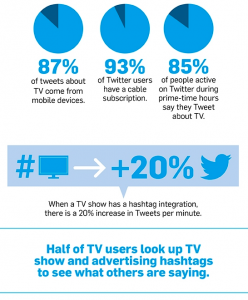By ISABELLA MESQUITA
Recent research conducted by Twitter revealed the importance of real-time tweets for the popularity and audience of broadcast and cable television.
New and rising media outlets such as Instagram, Twitter, Facebook, Buzzfeed, and other online news and search engines have grown among all generations causing television to lose much of its prominence and value in the past years.
However, a new research made by Twitter revealed that Twitter and other social media platforms can actually increase the interest for TV shows and programming and drive a greater audience to take action regarding a specific TV show.
According to Twitter’s global media and agency research director Anjali Midha, the talk about TV shows and its programming on Twitter strongly influences mainstream media as well as consumer attitudes and behaviors.
“There are actionable strategies and tactics that can help both programming content and advertising work harder by tapping into the power of their audiences,” said Midha.
In other words, through TV related posts on Twitter, advertising agencies, directors, anchors, hosts and all others responsible for television programming, gained a real-time access to the audience’s opinion about their work and thus are able to create and deliver material that directly meets the public’s expectations and needs.
Results from the research show that in 2014, 93 percent of Twitter users had a cable subscription and that 85 percent of people active on Twitter during prime-time hours Tweeted about TV. Also, every show with a hashtag integration, had a significant 20 percent increase in tweets per minute about it.
 –> Tweets about Television has influenced the audiences to:
–> Tweets about Television has influenced the audiences to:
– Take action on a show’s social media sites – 52 percent
– Search the show online (through Google, Yahoo, etc.) – 47 percent
– Follow TV show or talent on Twitter – 46 percent
– Search show on Netflix – 43 percent
– Plan to watch show later – 42 percent
Finally, with this increase in viewership and brand engagement, Twitter is reshaping the ‘TV landscape’ and ironically preventing television from becoming obsolete in an era where social media has taken over.
